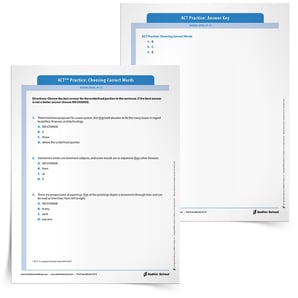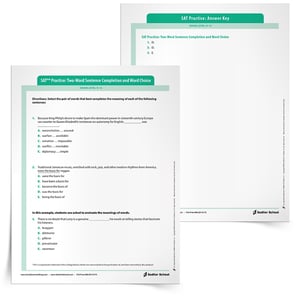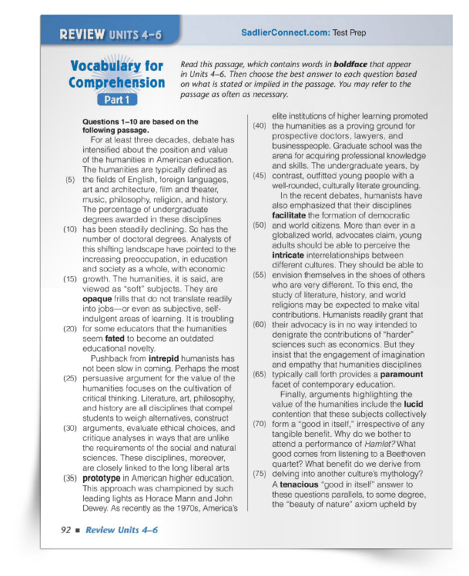June 26, 2017 VG Teaching Strategies Test-taking, Vocab Gal, ELA Resources - Assessment, ELA Resources - Activities, ELA PD - Assessment, ELA Resources - Tip Sheets, ELA 9-12, ELA Seasonal - Spring, ELA PD - Leadership, ELA PD - Grammar Writing, ELA PD - Vocabulary, ELA Focus - Grammar, ELA Focus - Vocabulary
An Awesome SAT and ACT Comparison for Teachers and Students
By: Vocab Gal
I will never forget driving to my SAT exam early one Saturday morning; I had the radio blaring classical music while I crunched peppermints and double-checked my supply of number two pencils and the state-issued ID in my lap. I had been practicing for a month using my floppy-disk SAT Review program and had pored over the SAT pamphlet so I’d know how much time I had for each section. I was ready!
My resulting score was good, due in no small part to the diligence I had exercised in learning the test format and pacing.
Yet not all students are as earnest as I was, and so it often falls on teachers to help students improve their test skills as well as their knowledge of the test itself.
I have a friend who teaches SAT/ACT test prep, and he tells me that he can improve students’ scores significantly by simply educating them about the test’s timing and by providing basic test practice.
With the Test Prep handouts and resources provided here, you can help your students make the same gains.
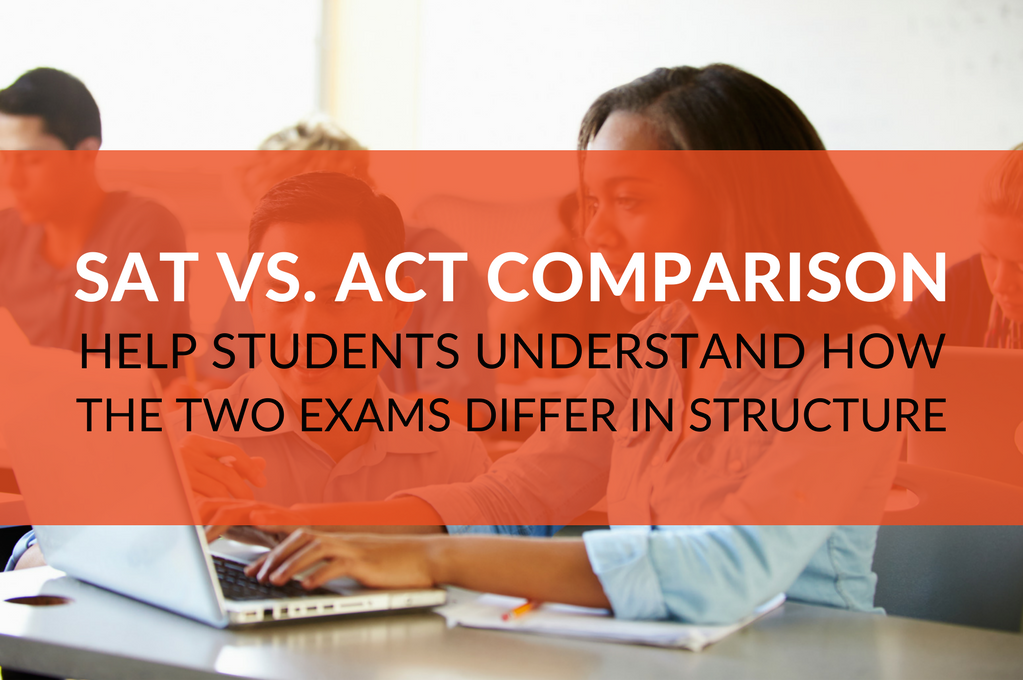
In order to teach the logistics of the exams, we first have to be familiar with all the changes to the SAT and ACT exams over the year. Even I have been quite confused for a long time about all of the changes that have been made.
That’s why I created the SAT vs. ACT Comparison Chart. Creating this chart helped me significantly to understand the difference between the ACT and SAT test (which seem to me to be pretty similar nowadays).
In this blog post I’ll further break down the different sections, timing, and basic strategies to help educate students about what the SAT and the ACT exams look like and therefore how best to prepare.
I know in my home state of Ohio, schools now give the SAT or ACT exams, for free to all juniors at the end of the school year. In our neighboring state of Michigan, the SAT exam is given to all juniors. Other states requiring the ACT exam for all high schoolers include Alabama, Hawaii, Kentucky, Louisiana, Mississippi, Missouri, Montana, Nevada, North Carolina, South Carolina, Tennessee, Utah, Wisconsin, and Wyoming.
This trend is highlighted as a way to save college-prep students money and to encourage other students—who may not have been considering college—to reconsider. Furthermore, these tests can be an end-of-course exam for juniors without having to give them additional tests.
However, if many of the students who take the test in any given school do very poorly, this can reflect negatively on the school. It is also a waste of money if students cannot show on the test the skills they have learned their junior year.
Therefore, it is critical that students understand the logistics of the SAT and ACT exams so they can perform at their very best.
Higher scores can translate into worthwhile scholarship opportunities and these scores can also become a major benchmark for measuring a teacher’s impact on his or her students.
It is imperative that teachers spend time understanding each test and ensuring students have the skills to be successful, as the outcomes can have significant consequences.
But first, let's discuss...
WHY IT'S IMPORTANT TO TAKE THE SAT AND ACT EXAMS
According to the SAT website’s Educator’s Guide, taking the SAT exam is:
“a critical step toward higher education for students of all backgrounds. It’s taken by more than 1.7 million unique test-takers every year and is accepted by all U.S. colleges and universities. When used in combination with high school GPA, SAT scores are shown to be the best predictors of a student’s potential to succeed in college. The SAT covers core content areas deemed essential for success in college—reading, math, and writing and language.”
According to the ACT website’s page for K-12 Educators and Administrators, the ACT exam:
“motivates students to perform to their best ability. Test scores reflect what students have learned throughout high school and provide colleges and universities with excellent information for recruiting, advising, placement, and retention. More than 2.1 million high school students in the graduating class of 2016 from all 50 states and many other countries took the ACT [and] ACT test scores are accepted by all four-year US colleges and universities, including highly selective institutions."
Clearly, the SAT and ACT exams have very similar goals and outcomes; the biggest differences seem to be the information needed for helping students prepare for the timed reading and analysis section of the ACT exam (the SAT exam provides more time for reading and answering questions).
DIFFERENCES BETWEEN ACT AND SAT TEST SECTIONS
SAT AND ACT COMPARISON: READING SECTIONS
To explain more fully, both the SAT and ACT reading tests have sets of individual reading passages and one set of paired passages each that require students to use reading and vocabulary analysis skills.
The ACT reading test includes three individual passages and one paired passage with 35 questions and only allows 40 minutes for completion.
The SAT test, on the other hand, includes four individual passages and one paired passage with 52 questions total, but allows much more time—65 minutes to be exact—for completion.
The skills are the same, so it is only the speed necessary to finish each test that makes time management a much more important factor in the ACT test than the SAT test reading test.
SAT AND ACT COMPARISON: WRITING SKILLS SECTIONS
Both the SAT and ACT exams include writing skills questions that assess the same skills, something that I had not fully understood before.
The ACT exam calls this test part the “English Test,” and it consists of five passages that students must read and critique with 75 multiple choice questions in 45 minutes.
The SAT exam names this section the “Writing and Language Test,” and it consists of four passages, each with 11 questions, that students must answer in 35 minutes.
Time management is less of a factor here, so really, both testing companies have recognized the importance of writing and grammar skills.
SAT AND ACT COMPARISON: SCIENCE SECTION
The ACT exam includes a “Scientific Reasoning” section that the SAT exam does not; instead, the SAT exam builds in graph/chart analysis into its Reading Test and measures it in a sub-score.
English teachers need to prepare students for this section as it focuses on reading and interpreting information—and more nonfiction data than simply prose texts.
SAT AND ACT COMPARISON: MATH SECTIONS
Both the SAT and ACT exams include mathematics sections that test essentially the same skills; the only difference is that the SAT exam separates the mathematics tests into two sections—one that allows for calculators and one that does not.
SAT AND ACT COMPARISON: ESSAYS
Finally, both the SAT and ACT exams include an optional essay component that asks students to read, analyze, and respond.
The differences between the two tests are that the ACT test asks students to read three different perspectives on a topic, analyze those perspectives, form their own opinion on the topic, and explain how their position compares with the given perspectives.
On the other hand, the SAT test asks students to read one passage and analyze its merits.
Both tests ask students to read, interpret, and use evidence to support their positions.
The SAT test again provides a slightly longer timeframe of 50 minutes in comparison to the ACT test’s 40-minute deadline.
As teachers, districts, and/or parishes attempt to provide systematic instruction to students about the ACT and/or SAT exams, the first step is to share the comparison chart with students, thus providing an understanding of what skills are going to be assessed.
ADDITIONAL RESOURCES TO HELP STUDENTS
If students are only going to take one exam, this fun quiz by the Princeton Review can help them potentially determine the test that is right for them.
However, if one exam or another has already been chosen by the school, district, parish, or state, these helpful student guides, created by the College Board and ACT companies, provide detailed explanations of the tests, the scoring methods, tips, sample tests, and even suggestions for more helpful resources.
SAT: https://collegereadiness.collegeboard.org/pdf/sat-student-guide.pdf
ACT: http://www.act.org/content/dam/act/unsecured/documents/Preparing-for-the-ACT.pdf
Sometimes the booklets highlighted in the links above can become overwhelming for students, however.
SAT VS. ACT COMPARISON CHART
That is why I created the SAT vs. ACT Comparison Chart breakdown and compiled the resources below. These items should make things easier for them, and for you, their teachers.
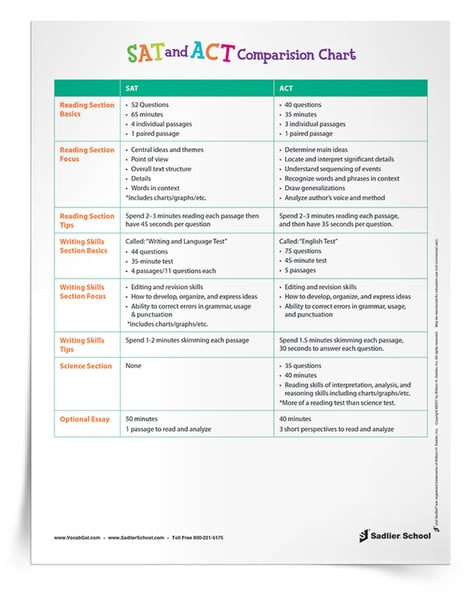
SAT AND ACT TEST PREP KIT
This bundle of resources is really helpful in giving students practical strategies for test taking success. It includes:
-
Top 3 Test Tips for ACT and SAT Tip Sheet
-
Top 5 Tips for ACT and SAT Test Prep Tip Sheet
-
Tips for Taking the ACT Writing Test
-
SAT Practice: Precise Words
-
ACT Practice: Subject-Verb Agreement
-
SAT Practice: Punctuation
-
ACT Practice: Verb Tenses
-
10 High-Stakes Test Terms to Know
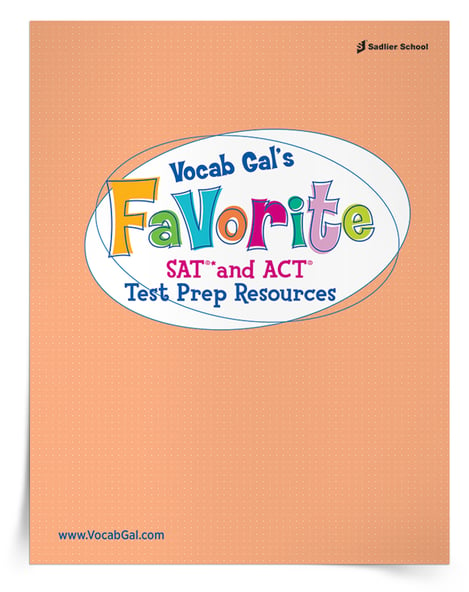
GRAMMAR SKILLS FOR SAT AND ACT EXAMS
Because the SAT and ACT exams are offered throughout the school year, teachers can help students to strengthen language and grammar skills all year long. Download the SAT and ACT Grammar Practice Worksheets to help students hone their grammar skills.
The SAT and ACT Grammar Pratice Worksheets include the following topics:
|
CHOOSING CORRECT WORDS |
SENTENCE COMPLETION |
VOCABULARY WORKSHOP SERIES
Additionally, Vocabulary Workshop books, and the new Vocabulary Workshop Achieve books can be an effortless way to integrate reading analysis skills, including context clue support.
This Vocabulary Workshop Series even have awesome SAT/ACT Test Prep book with high-interest nonfiction passages with questions that mirror both the SAT and ACT exams; see this sample page.
You can also download Vocabulary for Comprehension Activities from Vocabulary Workshop Achieve!
IN SUMMARY
Looking back, it seemed daunting to me to understand the difference between ACT and SAT tests, and indeed it took me an entire day of digging around on the ACT and SAT websites, as well as several other test-prep websites, before I was able to truly understand the tests’ similarities and differences.
In the end, they are more similar than I expected, and I found the biggest difference to be the time difference between the ACT and SAT Reading Tests.
Before providing content and skills instruction on what is assessed on these exams, help your students understand how the two tests differ in structure.
We owe it to them to truly understand both the ACT and SAT exams and, therefore, teach them the skills and strategies that will lead to success.





